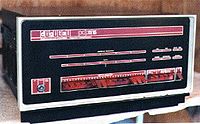Difference between revisions of "PDP-11/20"
(→hampage.hu: remove incorrect data (11/20 cards are larger, special purpose cards)) |
m (Link KA11) |
||
| Line 7: | Line 7: | ||
[[Image:PDP11-20.jpg|right|150px|thumb|PDP11/20]] | [[Image:PDP11-20.jpg|right|150px|thumb|PDP11/20]] | ||
| − | The PDP-11/20 was the first PDP-11; its KA11 | + | The PDP-11/20 was the first PDP-11; its [[KA11 CPU]] was built from a set of [[DEC card form factor|quad width extended-length]] cards, along with a few dual width. It introduced the [[UNIBUS]] as a universal path to connect together the CPU, memory and devices. |
It was the only one to use discrete logic for its control circuits, as opposed to [[micro-programming]] (this was because the cheap, fast [[ROM]]s needed for economical implementation did not exist yet at the time it was designed. | It was the only one to use discrete logic for its control circuits, as opposed to [[micro-programming]] (this was because the cheap, fast [[ROM]]s needed for economical implementation did not exist yet at the time it was designed. | ||
Revision as of 15:03, 14 September 2016
| PDP-11/20 | |
| Manufacturer: | Digital Equipment Corporation |
|---|---|
| Bus Architecture: | Unibus |
The PDP-11/20 was the first PDP-11; its KA11 CPU was built from a set of quad width extended-length cards, along with a few dual width. It introduced the UNIBUS as a universal path to connect together the CPU, memory and devices.
It was the only one to use discrete logic for its control circuits, as opposed to micro-programming (this was because the cheap, fast ROMs needed for economical implementation did not exist yet at the time it was designed.
Contents
Extensions
The -11/20 did not have, as standard components, many of the capabilities that later became standard on later models, such as hardware multiply and divide, floating point, and memory mapping. DEC provided a series of accessories that provided some of these capabilities.
One was a co-processor for the multiply/divide instructions; rather than additional instructions in the CPU, it was implemented as a device on the bus, making this model incompatible from the rest of the PDP-11's.
The KT11-B Paging Option was logically an addition to the CPU, interposed between the KA11 and the UNIBUS, but also tied into the CPU; it allowed hardware-based timesharing, and use of up to the full 248 KBytes of memory addressable by the UNIBUS.
Software
An -11/20 was the first PDP-11 to run Unix, albeit a very early version.
hampage.hu
Quoted: The first of the -11's, born in June 1970, featuring the KA11 processor.
The PDP-11/20 is a general-purpose computer with a wordlength of 16 bits. It features 8 general registers, and one interconnect for all system components (CPU, memory, peripheral devices), the UNIBUS (which is not the successor of the PDP8 OMNIBUS). This bus had an addressing range of 18 bits, but only 16 were used, which led to the 32 Kword (as mentioned, one word was 16 bits, so this is equal 64 Kbyte) memory limit. As with the other members of the -11 family, the top 4 KW of the memory is reserved to the system (the upper memory addresses refer to devices connected to the CPU). It is also interesting to know that most machines were shipped with only 12 KW of magnetic core memory.
On the picture to the left we can see some typical I/O devices: 4 ASR33 teletype terminals and DECtape drives over the an-fold papertape puncher/reader. The frontpanel had lights and switches for address and data (the lights were not LED's).
The original operating system was DOS/BATCH, but one of the early versions of UNIX was also developed on the /20.
.Interesting options: MX11 - Memory Extension Option: this enabled the usage of 128 KW memory (18-bit addressing range); KS11: this option provided hardware memory protection, which the plain /20 lacked. Both options were developed by the Digital CSS (Computer Special Systems).
Trivia: The machine is said to be named "PDP-11/30" originally, but it was renamed to 11/20 because of the similar designation of the IBM 1130.
misc
More information is available on the PDP-11 page...
| v • d • e PDP-11 Computers and Peripherals |
|---|
| UNIBUS PDP-11s - PDP-11/20 • PDP-11/15 • PDP-11/35 • PDP-11/40 • PDP-11/45 • PDP-11/50 • PDP-11/55 • PDP-11/70 PDP-11/05 • PDP-11/10 • PDP-11/04 • PDP-11/34 • PDP-11/60 • PDP-11/44 • PDP-11/24 • PDP-11/84 • PDP-11/94 QBUS PDP-11s - PDP-11/03 • PDP-11/23 • PDP-11/23+ • MicroPDP-11/73 • MicroPDP-11/53 • MicroPDP-11/83 • MicroPDP-11/93 QBUS CPUs: LSI-11 • LSI-11/2 • KDF11-A • KDF11-B • KDJ11-A • KDJ11-B • KDJ11-D • KDJ11-E Buses: UNIBUS • UNIBUS map • SPC • MUD • EUB • QBUS • CD interconnect • PMI Also: PDP-11 architecture • PDP-11 Extended Instruction Set • FP11 floating point • PDP-11 Memory Management |
| UNIBUS CPUs: KA11 • KC11 • KB11-A • KB11-B • KB11-C • KB11-D • KD11-A • KD11-B • KD11-D • KD11-E • KD11-EA • KD11-K • KD11-Z • KDF11-U
Co-processors: FP11-A • FP11-B • FP11-C • FP11-E • FP11-F • KE44-A • FPF11 Chips: LSI-11 • KEV11-A • KEV11-B • KEV11-C • F-11 • KEF11-A • KTF11-A • T-11 • J-11 • FPJ11 CPU options: KE11-E • KE11-F • KJ11-A • KT11-C • KT11-D • KK11-A • KK11-B • KT24 • KTJ11-B Rare CPU options: KS11 Memory Protection and Relocation option • KT11-B Paging Option • KUV11 Writeable Control Store Front panels: KY11-A • KY11-D • KY11-J • KY11-LA • KY11-LB • KY11-P More on buses: UNIBUS and QBUS termination • Bus Arbitration on the Unibus and QBUS • CTI BUS PDT-11s - PDT-11/110 • PDT-11/130 • PDT-11/150 CTI PDP-11s - PRO-325 • PRO-350 • PRO-380 Other: FIS floating point • PDP-11 Commercial Instruction Set • PDP-11 stacks • PDP-11 family differences |


